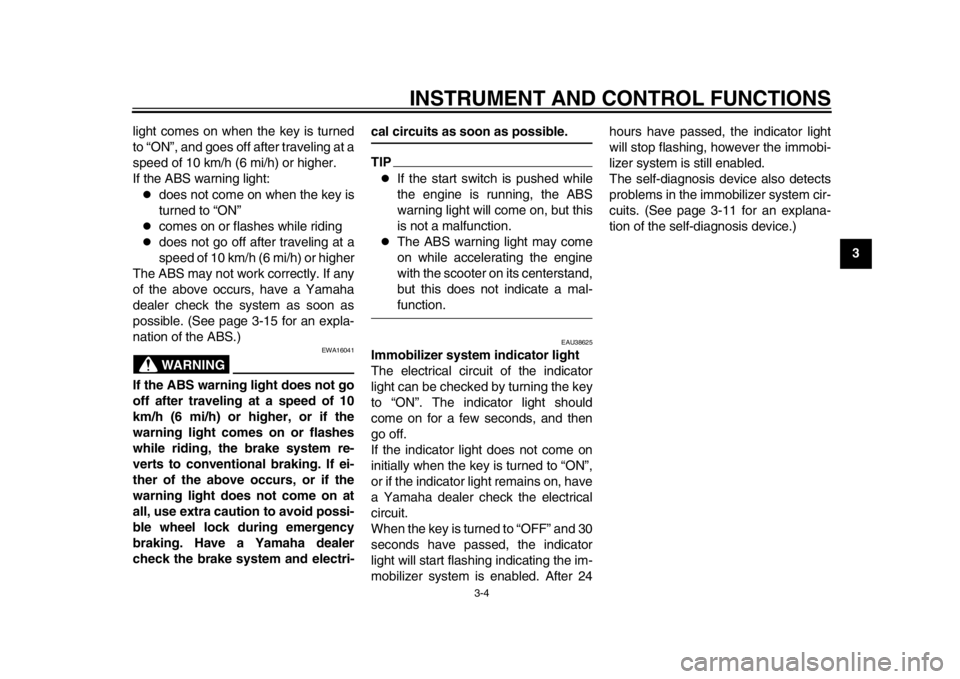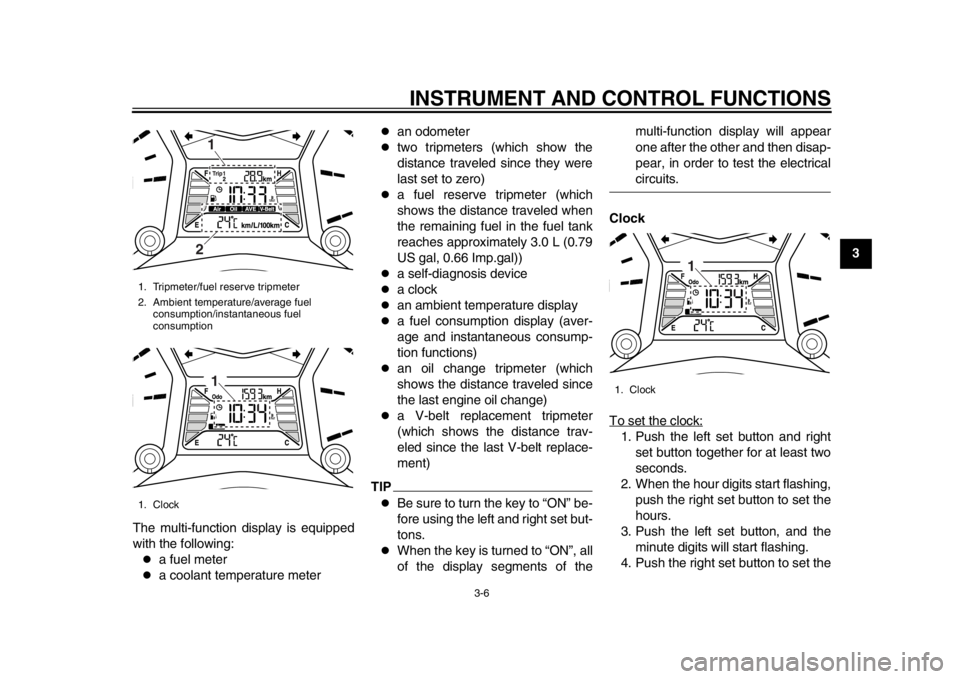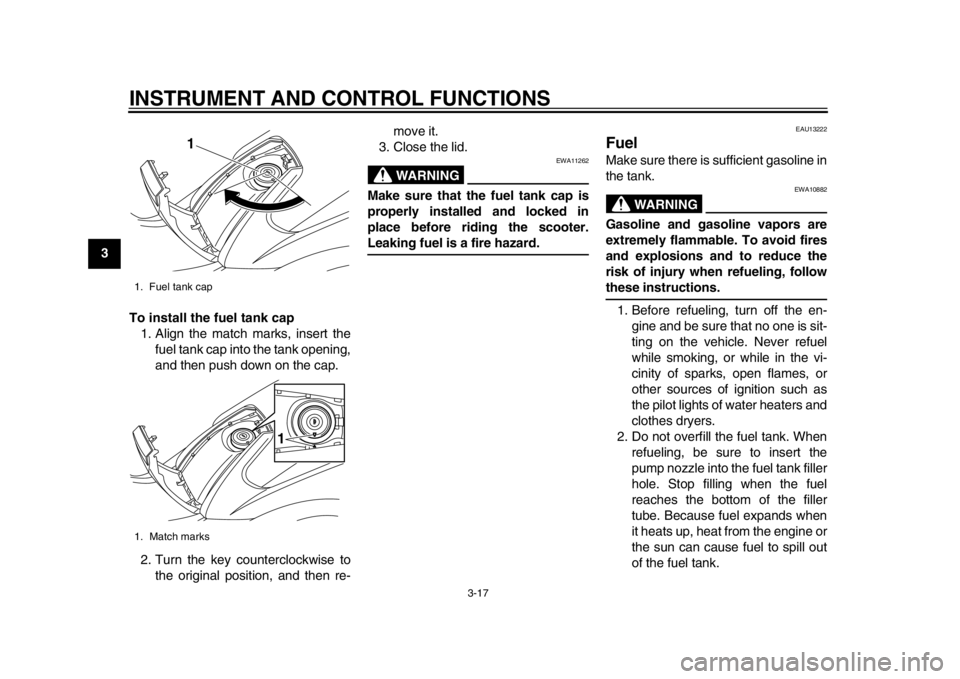lock YAMAHA TMAX 2014 Owners Manual
[x] Cancel search | Manufacturer: YAMAHA, Model Year: 2014, Model line: TMAX, Model: YAMAHA TMAX 2014Pages: 100, PDF Size: 3.01 MB
Page 6 of 100

TABLE OF CONTENTSSAFETY INFORMATION................... 1-1
Further safe-riding points................. 1-5
DESCRIPTION ................................... 2-1
Left view .......................................... 2-1
Right view ........................................ 2-2
Controls and instrument s................. 2-3
INSTRUMENT AND CONTROL
FUNCTIONS ....................................... 3-1
Immobilizer system ....... ................... 3-1
Main switch/steering lock................. 3-2
Indicator lights and warning lights ............................................. 3-3
Speedometer ................................... 3-5
Tachometer ..................................... 3-5
Multi-function display ....................... 3-5
Handlebar switches ....................... 3-12
Front brake lever ........................... 3-13
Rear brake lever ............................ 3-14
Rear brake lock lever..................... 3-15
ABS (for ABS models) .. ................. 3-15
Fuel tank cap ................................. 3-16
Fuel................................................ 3-17
Catalytic converter ......................... 3-19
Seat ............................................... 3-19
Adjusting the rider backrest ........... 3-20
Helmet holder ................................ 3-21
Storage compartments .................. 3-21
Windshield ..................................... 3-23
Rear view mirrors .......................... 3-25 Shock absorber assembly ............. 3-25
Sidestand ...................................... 3-26
Ignition circuit cut-
off system ......... 3-26
FOR YOUR SAFETY –
PRE-OPERATION CHECKS ............. 4-1
OPERATION AND IMPORTANT
RIDING POINTS ................................. 5-1
Starting the engine .......................... 5-1
Starting off ....................................... 5-2
Acceleration and deceleration ......... 5-3
Braking ............................................ 5-3
Tips for reducing fuel
consumption ................................ 5-4
Engine break-in ............................... 5-4
Parking ............................................ 5-5
PERIODIC MAINTENANCE AND
ADJUSTMENT ................................... 6-1
Owner’s tool kit................................ 6-2
Periodic maintenance chart for the emission control system .............. 6-3
General maintenance and lubrication chart ........................... 6-4
Removing and installing panels ...... 6-8
Checking the spark plugs .............. 6-10
Engine oil and oil filter cartridge .... 6-11
Coolant .......................................... 6-14
Replacing the air filter element...... 6-15 Adjusting the engine idling
speed............ ............................ .. 6-16
Checking the throttle grip free play ............................................. 6-17
Valve clearance ............................. 6-17
Tires ............................................... 6-17
Cast wheels ................................... 6-19
Checking the front and rear brake
lever free play ............................. 6-20
Adjusting the rear brake lock cable ........................................... 6-21
Checking the rear brake lock ......... 6-21
Checking the front and rear brake pads............................................ 6-22
Checking the brake fluid level ........ 6-23
Changing the brake fluid ................ 6-24
Drive belt slack .............................. 6-24
Checking and lubricating the cables ......................................... 6-24
Checking and lubricating the
throttle grip and cable ................. 6-25
Lubricating the front and rear brake levers ................................ 6-25
Checking and lubricating the centerstand and sidestand ......... 6-26
Checking the front fork................... 6-26
Checking the steering .................... 6-27
Checking the wheel bearings......... 6-27
Battery ........................................... 6-28
Replacing the fuses ....................... 6-30
Replacing the headlight bulb ......... 6-3259C-9-E2.book 1 ページ 2013年6月18日 火曜日 午後1時33分
Page 15 of 100

DESCRIPTION
2-3
23
4
5
6
7
8
9
EAU10431
Controls and instruments
4
2
3
6
7
8
1
11
9
5
10
12
1. Rear brake lever (page 3-14)
2. Left handlebar switches (page 3-12)
3. Rear brake lock lever (page 3-15)
4. Speedometer (page 3-5)
5. Multi-function display (page 3-5)
6. Tachometer (page 3-5)
7. Right handlebar switches (page 3-12)
8. Front brake lever (page 3-13)9. Throttle grip (page 6-17)
10.Front storage compartment B (page 3-21)
11.Main switch/steering lock (page 3-2)
12.Front storage compartment A (page 3-21)
59C-9-E2.book 3 ページ 2013年6月18日 火曜日 午後1時33分
Page 17 of 100

INSTRUMENT AND CONTROL FUNCTIONS
3-2
234
5
6
7
8
9
ference.
EAU10473
Main switch/steering lockThe main switch/steering lock controls
the ignition and lighting systems, and is
used to lock the steering. The various
positions are described below.TIPBe sure to use the standard key (black
bow) for regular use of the vehicle. To
minimize the risk of losing the code
re-registering key (red bow), keep it in a
safe place and only use it for codere-registering.
EAU10561
ON
All electrical circuits are supplied with
power; the meter lighting, taillight, li-
cense plate light and auxiliary lightcome on, and the engine can be start-
ed. The key cannot be removed.
TIPThe headlight comes on automatically
when the engine is started and stays on
until the key is turned to “OFF” or thesidestand is moved down.
EAU10662
OFF
All electrical syst
ems are off. The key
can be removed.
WARNING
EWA10062
Never turn the key to “OFF” or
“LOCK” while the vehicle is moving.
Otherwise the electrical systems will
be switched off, which may result inloss of control or an accident.
EAU10685
LOCK
The steering is locked, and all electrical
systems are off. The key can be re-
moved.
To lock the steering1. Turn the handlebars all the way to
59C-9-E2.book 2 ページ 2013年6月18日 火曜日 午後1時33分
Page 18 of 100

INSTRUMENT AND CONTROL FUNCTIONS
3-3
1
23
4
5
6
7
8
9the left.
2. Push the key in from the “OFF” po- sition, and then turn it to “LOCK”
while still pushing it.
3. Remove the key.
To unlock the steering
Push the key in, and then turn it to
“OFF” while still pushing it.
EAU34342
(Parking)
The steering is locked, and the taillight,
license plate light and auxiliary light are
on. The hazard lights and turn signal
lights can be turned on, but all other
electrical systems are off. The key can
be removed.
The steering must be locked before the
key can be turned to “ ”.NOTICE
ECA11021
Do not use the parking position for
an extended length of time, other-wise the battery may discharge.
EAU49394
Indicator lights and warning
lights
EAU11031
Turn signal indicator lights “ ” and
“”
The corresponding indicator light flash-
es when the turn signal switch is
pushed to the left or right.
EAU11081
High beam indicator light “ ”
This indicator light comes on when the high beam of the headlight is switched
on.
EAU43024
Engine trouble warning light “ ”
This warning light comes on if an elec-
trical circuit monitoring the engine is not
working correctly. If this occurs, have a
Yamaha dealer check the self-diagno-
sis system.
The electrical circui
t of the warning light
can be checked by turning the key to
“ON”. The warning light should come
on for a few seconds, and then go off.
If the warning light does not come on
initially when the key is turned to “ON”,
or if the warning light remains on, have
a Yamaha dealer check the electrical
circuit.TIPThis warning light will come on when
the key is turned to “ON” and the start
switch is pushed, but this does not indi-cate a malfunction.
EAU53991
ABS warning light “ ” (for ABS
models)
In normal operation, the ABS warning
1. Turn signal indicator lights “ ” and “ ”
2. High beam indicator light “ ”
3. Anti-lock Brake System (ABS) warning light “ ” (for ABS models)
4. Engine trouble warning light “ ”
5. Immobilizer system indicator light
1
541
1
2
3
ABS
ABS
59C-9-E2.book 3 ページ 2013年6月18日 火曜日 午後1時33分
Page 19 of 100

INSTRUMENT AND CONTROL FUNCTIONS
3-4
234
5
6
7
8
9
light comes on when the key is turned
to “ON”, and goes off after traveling at a
speed of 10 km/h (6 mi/h) or higher.
If the ABS warning light:
does not come on when the key is
turned to “ON”
comes on or flashes while riding
does not go off after traveling at a
speed of 10 km/h (6 mi/h) or higher
The ABS may not work correctly. If any
of the above occurs, have a Yamaha
dealer check the system as soon as
possible. (See page 3-15 for an expla-
nation of the ABS.)WARNING
EWA16041
If the ABS warning light does not go
off after traveling at a speed of 10
km/h (6 mi/h) or higher, or if the
warning light comes on or flashes
while riding, the brake system re-
verts to conventional braking. If ei-
ther of the above occurs, or if the
warning light does not come on at
all, use extra caution to avoid possi-
ble wheel lock during emergency
braking. Have a Yamaha dealer
check the brake system and electri-
cal circuits as soon as possible.TIP
If the start switch is pushed while
the engine is running, the ABS
warning light will come on, but this
is not a malfunction.
The ABS warning light may come
on while accelerating the engine
with the scooter on its centerstand,
but this does not indicate a mal-function.
EAU38625
Immobilizer system indicator light
The electrical circuit of the indicator
light can be checked by turning the key
to “ON”. The indicator light should
come on for a few seconds, and then
go off.
If the indicator light does not come on
initially when the key is turned to “ON”,
or if the indicator light remains on, have
a Yamaha dealer check the electrical
circuit.
When the key is turned to “OFF” and 30
seconds have passed, the indicator
light will start flashing indicating the im-
mobilizer system is enabled. After 24 hours have passed, the indicator light
will stop flashing, however the immobi-
lizer system is still enabled.
The self-diagnosis device also detects
problems in the immobilizer system cir-
cuits. (See page 3-11 for an explana-
tion of the self-diagnosis device.)
59C-9-E2.book 4 ページ 2013年6月18日 火曜日 午後1時33分
Page 21 of 100

INSTRUMENT AND CONTROL FUNCTIONS
3-6
234
5
6
7
8
9
The multi-function display is equipped
with the following:
a fuel meter
a coolant temperature meter
an odometer
two tripmeters (which show the
distance traveled since they were
last set to zero)
a fuel reserve tripmeter (which
shows the distance traveled when
the remaining fuel in the fuel tank
reaches approximately 3.0 L (0.79
US gal, 0.66 Imp.gal))
a self-diagnosis device
a clock
an ambient temperature display
a fuel consumption display (aver-
age and instantaneous consump-
tion functions)
an oil change tripmeter (which
shows the distance traveled since
the last engine oil change)
a V-belt replacement tripmeter
(which shows the distance trav-
eled since the last V-belt replace-
ment)
TIP
Be sure to turn the key to “ON” be-
fore using the left and right set but-
tons.
When the key is turned to “ON”, all
of the display segments of the multi-function display will appear
one after the other and then disap-
pear, in order to test the electrical
circuits.
Clock
To set the clock:
1. Push the left set button and right set button together for at least two
seconds.
2. When the hour digits start flashing, push the right set button to set the
hours.
3. Push the left set button, and the minute digits will start flashing.
4. Push the right set button to set the
1. Tripmeter/fuel reserve tripmeter
2. Ambient temperature/average fuel consumption/instantaneous fuel
consumption
1. Clock
211
1. Clock
1
59C-9-E2.book 6 ページ 2013年6月18日 火曜日 午後1時33分
Page 22 of 100

INSTRUMENT AND CONTROL FUNCTIONS
3-7
1
23
4
5
6
7
8
9minutes.
5. Push the left set button and then release it to start the clock.
Odometer and tripmeter modes
Pushing the left set button switches the
display between the odometer mode
and the tripmeter modes in the follow-
ing order:
Odo Trip 1 Trip 2 V-Belt Trip
Oil Trip Odo
When approximately 3.0 L (0.79 US
gal, 0.66 Imp.gal) of fuel remains in the
fuel tank, the display will automatically
change to the fuel reserve tripmeter
mode “Trip F” and start counting the
distance traveled from that point. In that
case, pushing the left set button switch-
es the display between the various trip-
meter and odometer modes in the
following order:
Odo Trip 1 Trip 2 Trip F V-Belt Trip
Oil Trip Odo
To reset a tripmeter, select it by push-
ing the left set button until “Trip F”, “Trip
1” or “Trip 2” is displayed. While “Trip
F”, “Trip 1” or “Trip 2” is displayed, push
the left set button for at least one sec-
ond. If you do not reset the fuel reserve
tripmeter manually, it will reset itself au-
tomatically and the display will return to
the prior mode after refueling and trav-
eling 5 km (3 mi).
TIPThe display cannot be changed back to“Trip F” after pushing the left set button.
Fuel meter
With the key in the “ON” position, the
1. Odometer/tripmeters/fuel reserve tripmeter
1. Oil change tripmeter
1
1
1. V-belt replacement tripmeter1
1. Fuel reserve tripmeter
1
59C-9-E2.book 7 ページ 2013年6月18日 火曜日 午後1時33分
Page 30 of 100

INSTRUMENT AND CONTROL FUNCTIONS
3-15
1
23
4
5
6
7
8
9
EAU12963
Rear brake lock leverThis vehicle is equipped with a rear
brake lock lever to prevent the rear
wheel from moving while stopped at
traffic signals, railroad crossings, etc.
To lock the rear wheel
Push the rear brake lock lever to the left
until it snaps into place.
To unlock the rear wheel
Push the rear brake lock lever back to
the original position.TIP
Be sure to check that the rear
wheel does not move when therear brake lock lever is applied.
To provide secure locking of the
rear wheel, apply the rear brake le-
ver first before moving the rearbrake lock lever to the left.WARNING
EWA12362
Never move the rear brake lock lever
to the left while the vehicle is mov-
ing, otherwise loss of control or an
accident may result. Make sure that
the vehicle is stopped before mov-
ing the rear brake lock lever to theleft.
EAU54001
ABS (for ABS models)The Yamaha ABS (Anti-lock Brake
System) features a dual electronic con-
trol system, which acts on the front and
rear brakes independently.
Operate the brakes with ABS as you
would conventional brakes. If the ABS
is activated, a pulsating sensation may
be felt at the brake levers. In this situa-
tion, continue to apply the brakes and
let the ABS work; do not “pump” the
brakes as this will reduce braking effec-
tiveness.
WARNING
EWA16051
Always keep a sufficient distance
from the vehicle ahead to match the
riding speed even with ABS.
The ABS performs best with
long braking distances.
On certain surfaces, such as
rough or gravel roads, the brak-
ing distance may be longer withthe ABS than without.
The ABS is monitored by an ECU,
which will revert the system to conven-
tional braking if a malfunction occurs.
1. Rear brake lock lever
1
59C-9-E2.book 15 ページ 2013年6月18日 火曜日 午後1時33分
Page 31 of 100

INSTRUMENT AND CONTROL FUNCTIONS
3-16
234
5
6
7
8
9
TIP
The ABS performs a self-diagno-
sis test each time the vehicle first
starts off after the key is turned to
“ON” and the vehicle has traveled
at a speed of 10 km/h (6 mi/h) or
higher. During this test, a “clicking”
noise can be heard from the front
of the vehicle, and if either brake
lever is even slightly applied, a vi-
bration can be felt at the lever, but
these do not indicate a malfunc-
tion.
This ABS has a test mode which
allows the owner to experience the
pulsation at the brake levers when
the ABS is operating. However,
special tools are required, so
please consult your Yamaha deal-er when performing this test.
NOTICE
ECA16121
Keep any type of magnets (including
magnetic pick-up tools, magnetic
screwdrivers, etc.) away from the
front and rear wheel hubs, otherwise
the magnetic rotors equipped in the
wheel hubs may be damaged, result- ing in improper performance of the
ABS system.
EAU13176
Fuel tank capTo remove the fuel tank cap
1. Open the lid by pulling the lever up.
2. Insert the key into the lock and turn it clockwise. The lock will be re-
leased and the fuel tank cap can
be removed.
1. Front wheel hub
1. Rear wheel hub
11
1. Opening lever
2. Lid
1
2
59C-9-E2.book 16 ページ 2013年6月18日 火曜日 午後1時33分
Page 32 of 100

INSTRUMENT AND CONTROL FUNCTIONS
3-17
1
23
4
5
6
7
8
9To install the fuel tank cap
1. Align the match marks, insert the fuel tank cap into the tank opening,
and then push down on the cap.
2. Turn the key counterclockwise to the original position, and then re- move it.
3. Close the lid.
WARNING
EWA11262
Make sure that the fuel tank cap is
properly installed and locked in
place before riding the scooter.Leaking fuel is a fire hazard.
EAU13222
FuelMake sure there is sufficient gasoline in
the tank.
WARNING
EWA10882
Gasoline and gasoline vapors are
extremely flammable. To avoid fires
and explosions and to reduce the
risk of injury when refueling, followthese instructions.
1. Before refueling, turn off the en- gine and be sure that no one is sit-
ting on the vehicle. Never refuel
while smoking, or while in the vi-
cinity of sparks, open flames, or
other sources of ignition such as
the pilot lights of water heaters and
clothes dryers.
2. Do not overfill the fuel tank. When refueling, be sure to insert the
pump nozzle into the fuel tank filler
hole. Stop filling when the fuel
reaches the bottom of the filler
tube. Because fuel expands when
it heats up, heat from the engine or
the sun can cause fuel to spill out
of the fuel tank.
1. Fuel tank cap
1. Match marks
1
1
59C-9-E2.book 17 ページ 2013年6月18日 火曜日 午後1時33分